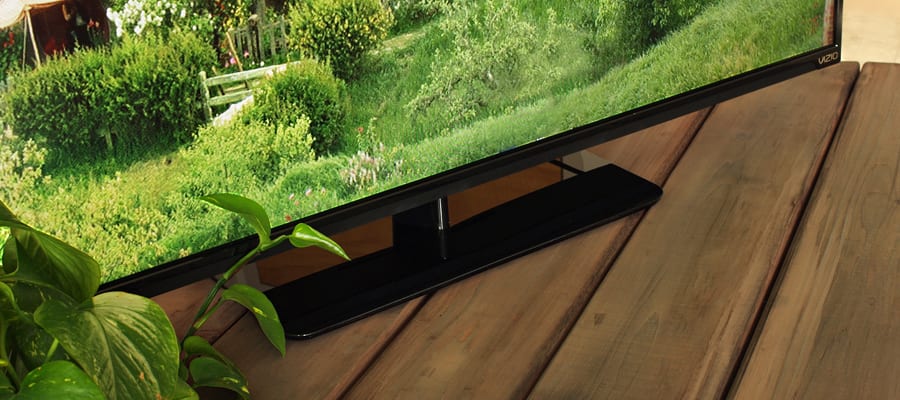This 48-inch display received high marks during our battery of lab tests, due heavily in part to its effective local dimming. The solid black levels and smooth motion we tested solve most of what's wrong with LCD TVs these days.
At this size and price, we heartily recommend Vizio's E-Series to any consumer looking to cut costs without cutting picture quality. It may have an uninspired design composed primarily of cheap plastic, but in this TV's case, it's definitely the insides that count.
Video Review
{{brightcove '3309503400001'}}
The Picture
Full array for the win!
As our first TV of 2014, the Vizio E480i-B2 has some stiff competition from last year: some of the best plasmas ever; the first fledgling UHD TVs; and two OLED titans. Yet compared to its LED peers, Vizio's new E-Series doesn't just look okay—it looks great.
We watched a couple of nature documentaries on Netflix—even while streaming over a wireless signal, they looked crisp and vibrant. Our Blu-rays of The Hobbit: An Unexpected Journey and Star Wars: A New Hope looked no worse than last year's mid-range plasmas, albeit black levels weren't quite as dark and motion wasn't quite as smooth.
The stellar picture quality owes a lot to the TV's full-array LED backlight. Unlike edgelit TVs, the E480i-B2 has LEDs behind the entire screen, not just around the borders. The results—combined with judicious local dimming—were very favorable. This isn't the brightest TV on the market, but it's certainly bright enough, even in the Calibrated Dark picture mode we used during testing. Black levels were very impressive for an LCD, too, as was the accuracy of all colors. Best of all? No blooming, a common problem associated with local dimming where the dim LEDs create halos of light around objects on screen.
There is one place this Vizio could improve, however. To get the best picture, you'll want to make sure you get a center seat: The viewing angle simply isn't very good, and you'll notice a major drop in picture quality at off-angles.
The new E-Series TVs wield 120 Hz refresh rates, and it's a big improvement over the 60 Hz iterations. There weren't any smoothing or de-judder options here, but this TV handles fast motion well nonetheless. Without looking overly smooth, complex action scenes remained mostly blur-free, and only intense camera panning caused any noticeable shift in frame rate. In short: This Vizio handles motion better than many LCDs from last year. Here's hoping all the 2014 TVs do.
Last but not least, the E480i-B2 packs a sonic punch. As long as you're not accustomed to a home theater sound system or a sound bar, you'll be pleased with this TV's integrated speakers. Though they're just the standard double 10w affair, the volume leveling and surround sound imitation can ruffle toupées.
Update 3/03/2014: We tested this Vizio's input lag in the Game picture mode and were very impressed: There was simply no discernable delay between stick/button presses and the response in the game. This was some of the smoothest LCD response I've tested. The drawback to the Game picture mode is that it dims the screen considerably, and disables the local dimming out of necessity. It's worth it, though—expect extremely smooth performance. Lastly, be sure to check for firmware upgrades regularly, like the one Vizio just rolled out that offers added motion controls.
For my calibrated picture settings and the data collected during the testing process, check out the Science Page.
The Design
tel·e·vi·sion [tel-uh-vizh-uhn]
What's the premium TV trend? Bigger, thinner, and lighter. The entry-level E480i-B2 doesn't compete on that front—the "black rectangle attached to another black rectangle" look isn't going to impress anyone. Okay, I'll concede that it's thinner than last year's Vizio crop, and the 10mm bezels are a nice touch.
We like the accompanying remote, however. An intuitive button layout simplifies most tasks, though the response speed of the IR input leaves something to be desired. Typing in our WiFi password was frustrating, and had nothing on a traditional keyboard. The short, wide clicker is fully accessible without adjusting your grip, but the cheap plastic design lacks heft and feels easy to break.
Vizio includes plenty of video connection options, at least for an entry-level model. On the TV's right side, you'll find a single HDMI input, USB input, and both optical and analog audio out jacks—great news for videophiles and gamers alike, what with the rising prevalence of sound bars. On the back of the TV are two more HDMI inputs, including one that serves as an ARC (audio return channel). You'll also find a shared component/composite input, LAN hookup, and coaxial jack for cable or satellite.
{{ photo_gallery "design" }}
The Experience
"Vizio Internet Apps" gets a needed boost
Is it finally time to get excited about Vizio's 2014 smart platform? It's much faster than it was last year. Apps still line the bottom of the screen—we'll call this a "quick selection bar"—when you press the V.I.A. (Vizio Internet Apps) button. You can also get a full screen view if you hold the button for a couple of seconds. From here, users can add, re-arrange, or delete pre-loaded apps to customize the quick selection bar.
Vizio appears to have quite a few new app partnerships under its belt, including a baker's dozen of local news networks. Highlights include Hulu Plus, VUDU, YouTube, Twitter, Pandora, eBay, and a few PlayJam games. That's pretty much it, though—no browser or first-party app store.
There are six picture mode pre-sets: Standard, Calibrated, Calibrated Dark, Vivid, Game, and Computer. Every picture mode can toggle between color temperature pre-sets, or adjust via the standard controls—Backlight, Contrast, Brightness, Color, etc. RGB sub-pixel balance may be altered via the color temperature menu, but there's no CMS (color management system). Calibrators can only tweak the E480i-B2 so much.
Finally, methodical users will notice a few extra settings in the Advanced Picture menu. Settings like Black Detail and Auto Brightness Control can almost certainly be turned off without hurting the picture, but Smart Dimming—the toggle for the TV's full-array local dimming—should stay on. A big chunk of this TV's picture quality stems from its six local dimming zones, which operate to help maintain both screen uniformity and black level.
{{ photo_gallery "software" }}
End Credits
A great picture at a great price
Vizio's new E-Series is hard to argue with. For a little under $600, you're buying what's simply a stellar 48-inch panel, with great audio, useful local dimming, top-tier apps, and a forward-thinking 120 Hz refresh rate. Other than its stingy viewing angle and mild judder during panning, the E480i-B2 is simply awesome—a great first look at the 2014 TV crop.
The real question is, how will it compare to the 2014 models from Panasonic, Sony, LG, and Samsung? While the entry-level E480i-B2 is cheap and chintzy on the outside, its picture quality wins out when compared to last year's premium LCDs, and simply blows away similarly-priced competition.
Behind the Screens
The Vizio E480i-B2 (MSRP $589.99) passed almost all of our tests with flying colors. A great black level, plenty of luminance, accurate colors, and smooth motion are about all you need for a great picture, and this Vizio doesn't disappoint. It would be a perfect 10 with a better viewing angle and a little more detail retention during motion panning—but for this price, we're still very impressed.
Calibration
The E480i-B2 has a number of picture modes, six in total, but Calibrated Dark is the most accurate. One drawback of the E-Series is its lack of full calibration controls—there's only 2-point grayscale controls here, no CMS. I adjusted the backlight, RGB balance, and "Black Detail" (Gamma) setting, but the basic controls didn't need any tweaking. Below, you'll find the default settings for Calibrated Dark beside my final calibration settings.
We'd also like to note that the Calibrated picture mode uses incorrect reference levels for TV legal limits (16-235). Basically, its Brightness control is set too high (at 55), which makes blacks look gray and buries picture elements into the production zone usually found below step 16.
Contrast Ratio
While the E480i-B2's contrast ratio isn't mind-blowing, its overall results are all above average, bolstered by very solid black levels. Using the ANSI checkerboard pattern, I measured a black level of 0.042 cd/m2 and a peak white of 143 cd/m2 in Calibrated Dark mode (Backlight 60), with white levels up to 220 cd/m2 at higher backlight levels.
The resulting contrast ratio of 3404:1 is a little less than Vizio's E-Series from last year, but it's still plenty of black/white differentiation where solid picture quality is concerned. I was most impressed by the integrity of this TV's black levels, which—with local dimming enabled—upheld their inky quality even along the edges and corners of the screen.
Turning up the backlight will raise the peak brightness and black levels, too, but you can still expect about 0.10 cd/m2 even at max backlight—plenty dark for a bright room.
Viewing Angle
The E480i-B2's viewing angle is probably its weakest area—you'll want to sit front and center, lest you risk serious picture degradation and color shifting. This is a common problem owing to the way LCD TVs are constructed. I tested a total viewing angle of 36°, or ±18° from the center to either side of the screen. This is pretty standard—poor as it is—compared to the E480i's peers from 2013.
Color Gamut
Testing revealed that the E480i-B2 is capable of very accurate color reproduction. Adhering to the Rec. 709 standard, this Vizio reproduces red, blue, green, cyan, magenta, yellow, and white almost exactly as it should, with only mild, imperceptible differences in hue and saturation. If you want a more bright and flashy look, try the Vivid picture mode, but know that professional video content will likely suffer loss of detail in this mode.
Grayscale & RGB Balance
As usual, we found errors in this Vizio's grayscale production and underlying RGB balance, two performance results that are intimately linked. Grayscale refers to the TV's production of black, gray, and white, while the red, green, and blue sub-pixels create the grayscale.
Using the TV's 2-point grayscale controls, I was able to cinch down discrepancies in the RGB balance which reduced a good amount of error within the grayscale. The pre-calibration DeltaE of 4.25 was reduced to 3.84—not perfect, but better.
A closer look at the E480i-B2's RGB balance revealed that it favors the blue sub-pixel over the red and green. Fortunately, reducing the presence of blue in 60-100 IRE evened out green and red somewhat—and there was no need to touch 10-50 IRE, they sort of just fell into place.
Gamma Sum
The E480i-B2 doesn't have a dedicated gamma control, but under the Advanced Picture settings we found a Black Detail option that seems to handle the task—sneaky sneaky. Gamma refers to the intensity of luminance growth between intervals of the grayscale. With Black Detail set to "Off" (i.e. gamma at default), the E480i was prone to ramp too quickly out of black and into dark gray, testing with a gamma of 2.19. With Black Detail set to "Low," I got closer to the 2.4 gamma ideal, hitting a sum of 2.49.
Meet the tester
Lee was Reviewed's point person for most television and home theater products from 2012 until early 2022. Lee received Level II certification in TV calibration from the Imaging Science Foundation in 2013. As Editor of the Home Theater vertical, Lee oversaw reviews of TVs, monitors, soundbars, and Bluetooth speakers. He also reviewed headphones, and has a background in music performance.
Checking our work.
Our team is here for one purpose: to help you buy the best stuff and love what you own. Our writers, editors, and lab technicians obsess over the products we cover to make sure you're confident and satisfied. Have a different opinion about something we recommend? Email us and we'll compare notes.
Shoot us an email




